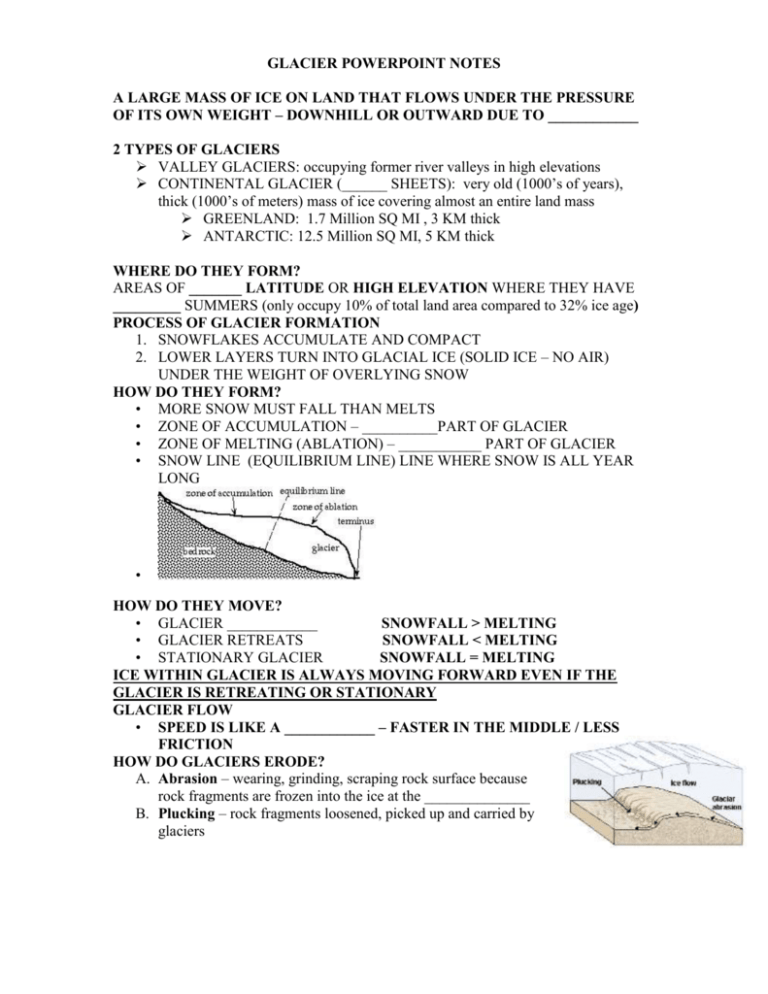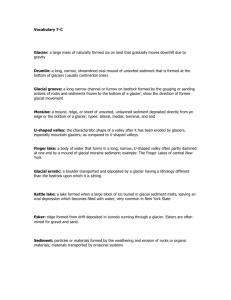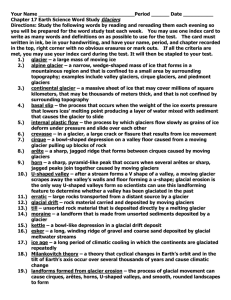GLACIER POWERPOINT NOTES
advertisement

GLACIER POWERPOINT NOTES A LARGE MASS OF ICE ON LAND THAT FLOWS UNDER THE PRESSURE OF ITS OWN WEIGHT – DOWNHILL OR OUTWARD DUE TO ____________ 2 TYPES OF GLACIERS VALLEY GLACIERS: occupying former river valleys in high elevations CONTINENTAL GLACIER (______ SHEETS): very old (1000’s of years), thick (1000’s of meters) mass of ice covering almost an entire land mass GREENLAND: 1.7 Million SQ MI , 3 KM thick ANTARCTIC: 12.5 Million SQ MI, 5 KM thick WHERE DO THEY FORM? AREAS OF _______ LATITUDE OR HIGH ELEVATION WHERE THEY HAVE _________ SUMMERS (only occupy 10% of total land area compared to 32% ice age) PROCESS OF GLACIER FORMATION 1. SNOWFLAKES ACCUMULATE AND COMPACT 2. LOWER LAYERS TURN INTO GLACIAL ICE (SOLID ICE – NO AIR) UNDER THE WEIGHT OF OVERLYING SNOW HOW DO THEY FORM? • MORE SNOW MUST FALL THAN MELTS • ZONE OF ACCUMULATION – __________PART OF GLACIER • ZONE OF MELTING (ABLATION) – ___________ PART OF GLACIER • SNOW LINE (EQUILIBRIUM LINE) LINE WHERE SNOW IS ALL YEAR LONG • HOW DO THEY MOVE? • GLACIER ____________ SNOWFALL > MELTING • GLACIER RETREATS SNOWFALL < MELTING • STATIONARY GLACIER SNOWFALL = MELTING ICE WITHIN GLACIER IS ALWAYS MOVING FORWARD EVEN IF THE GLACIER IS RETREATING OR STATIONARY GLACIER FLOW • SPEED IS LIKE A ____________ – FASTER IN THE MIDDLE / LESS FRICTION HOW DO GLACIERS ERODE? A. Abrasion – wearing, grinding, scraping rock surface because rock fragments are frozen into the ice at the ______________ B. Plucking – rock fragments loosened, picked up and carried by glaciers GLACIER EROSIONAL FEATURES FORMER ______SHAPED RIVER VALLEYS TO _______SHAPED VALLEYS CIRQUES: semi-circular shaped bowl created as a glacier scours back toward the mountain (1st place snow and ice accumulate) ARÊTES: steep-sided, sharp-edged bedrock ridge formed by two glaciers eroding away on opposite sides of cirques HORNS: 3 or more cirques adjacent to one another TARNS: glacial lakes produced by glacial scouring- often found in cirques HANGING VALLEYS: valley eroded by a small tributary glacier ______________ - Grooves carved into the bedrock by pebbles and cobbles carried at the bottom of a glacier – can show direction of glacial movement Polished Bedrock – LOOKS SHINY TILL(SEDIMENT) - is angular to sub-round and _______ SORTED AND NOT LAYERED GLACIER DEPOSITIONAL FEATURES ________________ – UNSORTED AND UNLAYERED pile of till There are many types of moraines Lateral – till along side of glacier Medial – 2 glaciers come together and the lateral moraines join in a single ridge TERMINAL or _________– farthest advance of glacier Recessional – glacier retreats, pauses, deposits – will be parallel to terminal moraine Kettle Lake ERRATICS – BOULDERS DROPPED BY Drumlins GLACIER – DO NOT MATCH BEDROCK CONTINENTAL GLACIERS EROSIONAL FEATURES Most flow over flatter land so more rounded hills, lakes (Finger Lakes), swamps Till Moraine-dammed lake n lai Esker tw Ou hp as Glacial Stream Terminal Moraine CONTINENTAL GLACIERS DEPOSITIONAL FEATURES MORAINES ____________ - ground moraine that is mounded into a stream-lined oval shape hill (inverted spoon) – steep side points in direction the glacier came from KETTLE LAKES – large, buried ice blocks melted and left depressions. Ex. Lake Ronkonkoma OUTWASH PLAIN - deposits made by STREAMS after glaciers melt (SORTED/LAYERED)








